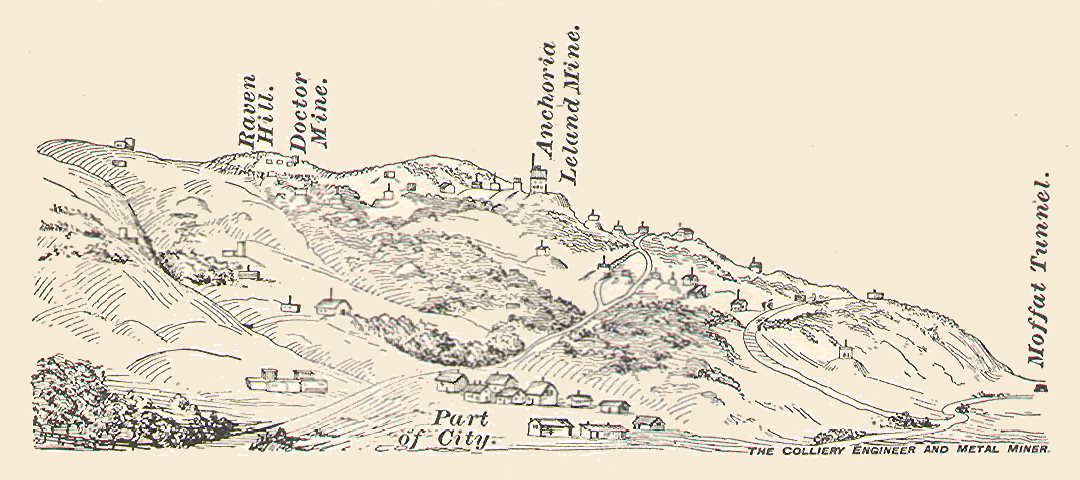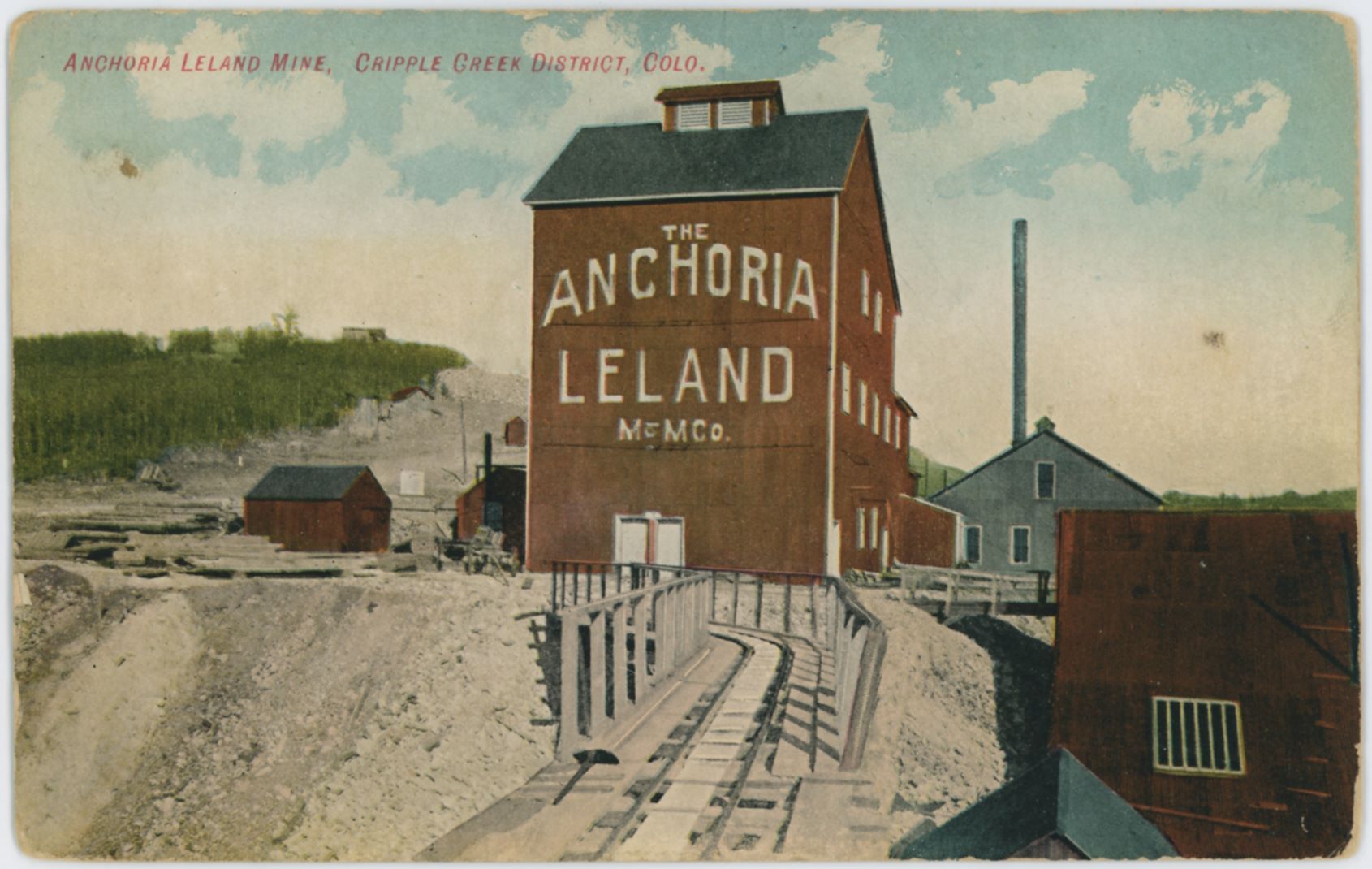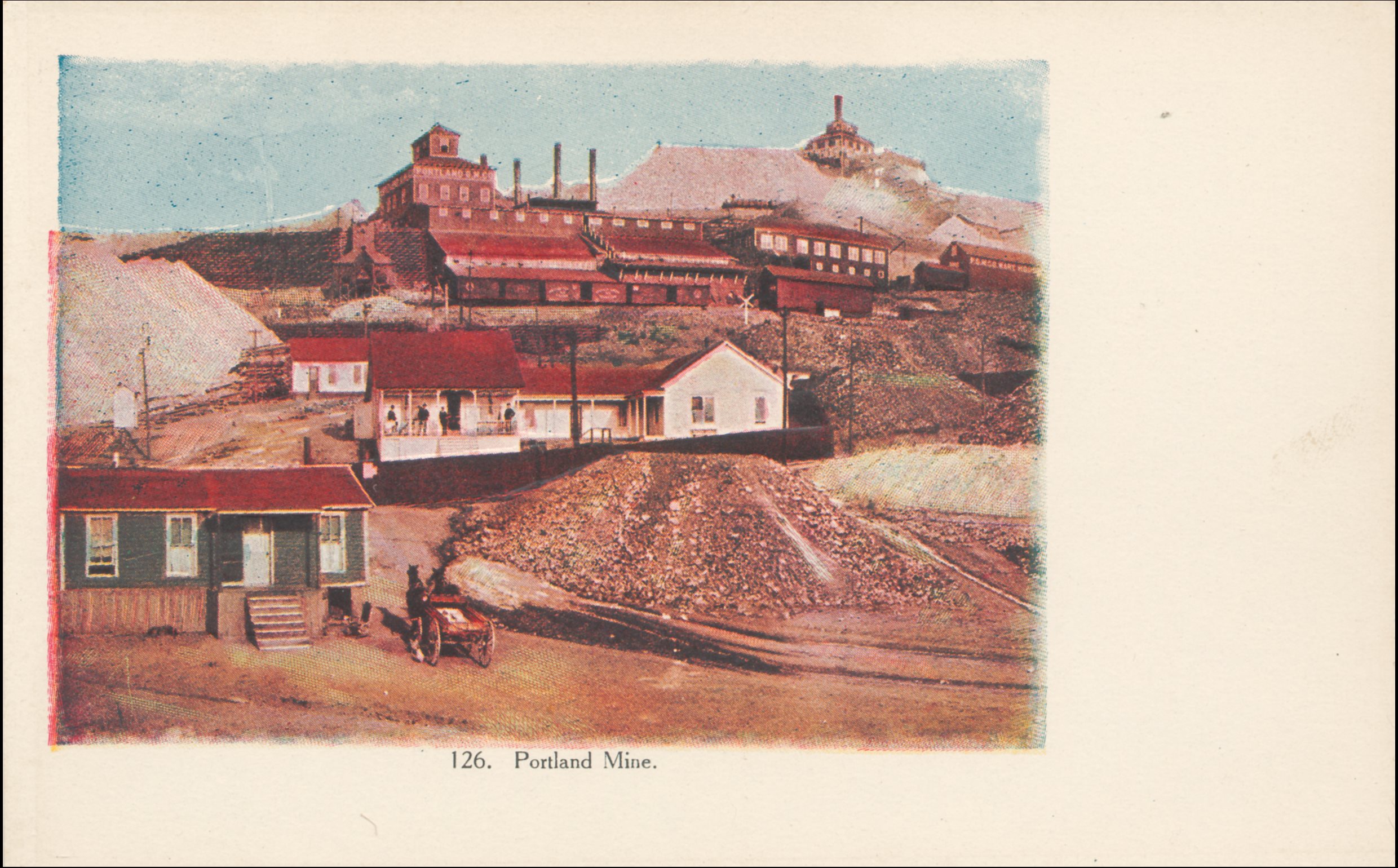-> My Collection; No source to show as I've not shared/scanned the Mining Journal as an album.
But, here is a link to first page on Hathi Trust Digital Library website.
September, 1896 (page 58->59)
Source had no images, only 1 sketch, so I used some images from my collection.
It is a year since we were at Cripple Creek. In that time the town has been burned to the ground, and again partially rebuilt on a more substantial scale. Numbers of new mines have been developed, former mere prospects have become mines, and there is scarcely a square acre that has not a hole of some kind on it, so that the entire area of Cripple Creek looks like a gigantic prairie dog town, or as if the country had broken out with an epidemic of small pox.
We left Colorado Springs by stage at noon and wound our way gradually through the mass of Pike's peak along the edge of Cheyenne canyon, passing very near the spot where the poetess and well known writer, Helen Hunt, better known as H. H., was buried at her own request. The grave stands on the top of a pine-clad hill overlooking Cheyenne canyon and looking outwards between a vista of red granite cliffs onto her favorite scene of cloud flecked prairie mingling with and lost in that distance where heaven and earth seem to meet and blend. The granite of this region is remarkable for its rapid disintegration into a coarse gravel composed largely of red feldspar ; the mica or hornblende seems to be the weak point in this granite which by oxidation rusts out, setting loose the other elements, viz., quartz and feldspar.
There are not many quartz veins traversing this homogeneous granite of the mountain and only a few have been found as yet to be mineral bearing and have been but partially opened. The main mass of coarse granite appears to have been cut and traversed by a younger and finer-grained eruptive granite which appears locally in dykes or veins. The upper portion of the peak is of a porphyritic granite with a fine grained reddish base in which distinct crystals of orthoclase feldspar are set conspicuously.
The whole region of Pike's peak has been greatly sculptured by glaciers whose homes and starting places were at the summit of the peak in immense and deep punchbowls, from which the glaciers descended through radiating valleys towards the plains, passing over many abrupt step-like precipices and leaving in their wake many beautiful basins filled with water, now utilized as reservoirs by the water system of Colorado Springs city. It was through such a region of characteristic Pike's peak granite that we rode for many hours till towards nightfall we caught sight of the lights of the mines of Bull hill twinkling here and there among the dense darkness of the Cripple Creek hills.
When within a few miles of there, the driver of the coach showed us the exact spot where the coach had been held up by desperadoes only two nights previous, a lonely place well chosen with rocks on either side for concealment. Soon after this we emerged from the Pike's peak granite onto the more open rolling hills of the Cripple Creek region composed of soft volcanic breccia resting on granite, the position of the former indicated by the growth of quaking-aspen trees, and the outcrop of the latter by fir trees. Reaching in the clear, starry night the brow of a hill we looked down at once upon a surprising and beautiful scene, it was the city of Cripple Creek lying spread out in the open valley some thousands of feet below us, illuminated from end to end with arc and other electric lights. It reminded us of the World's Fair at Chicago when seen from a distance on an illumination night. A kind of ghostly illumination ascending from the town was reflected in the heavens above. Beyond lay the distant peaks of the Sangre de Christo range sharply outlined against the starlit sky.
Could it be possible that this beautiful mirage of a city was the Cripple Creek city wiped almost out of existence by the great fire but three months ago? Soon we were plunging down the steep hill and entering the town at full gallop through its principal street. Here on either side of us instead of the old wooden shacks were tall brick buildings with city-like stores, all open for business whilst others were in process of completion. On one side was a fine hotel in process of erection that bids fair to equal some of our best in great cities, here again were churches rebuilding.
It is evident that the town is to be remodeled, to be no more a mere mining camp, but a city like Leadville. Some of the streets were almost impassable from piles of brick and boards and scaffoldings and building material for the buildings being erected with lightninglike speed and push. Here and there back of these buildings or along portions of the byways were charred ruins and that peculiar smell after a shower, proceeding from the charred timbers of the old town, from whose ashes the present is rising Phoenix like. Wonderful indeed to see a city thus rebuilt in three months, and looking as if it had always been there and nothing particular had ever happened to it.
THE NEW MINES.
From the town so completely new to us, we turn to the hillsides and see many of them spotted over with mines where formerly there was scarcely a prospect, and as for prospect holes, there did not seem a square acre that was not speckled with them. Never, we think, has there been a mining region so intensely probed and prospected. The reason of this is to be looked for in the absence of all guiding outcrops of veins and the blissful uncertainty of the position of ore deposits in the area, so that having no guide to go by, the best thing to do was to get hold of an acre and commence drilling holes all over it to see what you could find.
How a formerly but little noted hill, marked as we remembered it by but a few seemingly unimportant prospect holes, may develop, is well shown in Gold hill. This once barren unpromising area is now covered with important mines, whilst prospect holes are too numerous to mention. Above them all towers the lofty buildings of the Anchoria Leland mine, the principal one on the hill, as shown in our rough sketch.
The shaft in this mine is down 500 feet and over it is one of the finest hoisting plants in the country. The ore body like so many in Cripple Creek lies in a dyke of phonolite traversing the overlying mass of andesitic breccia. The dyke like that of the Moose, C. O. D., Elkton and others, is, we understand, traversed by virtually parallel shearing planes, in the interstices of which, associated with quartzose matter is the main body of the ore ; with depth the ore becomes more pyritous. Though they have gone down 500 feet, there is as yet no sign of the underlying granite, nor did we hear of any satisfactory case yet in Cripple Creek, where the breccia cap had been penetrated and the course of the vein followed definitely into the granite, though there were plenty of cases where mineralized dykes or geyser vents like that of the Independence and Portland were continuing downward, as might be expected, without interruption, with granite walls on either side.
From Gold hill we looked over to the distant Raven hill, to see several mines clustered around the top, quite new to us, conspicuous among them the Doctor mine, which of late has proved one of the richest in the camp, sending out many carloads of almost fabulously rich ore.
TUNNEL SCHEMES.
Below the town on the bank of the creek we found a gigantic tunnel scheme in progress, called the Moffatt tunnel, which is being driven in to crosscut the main portion of the mining area to find what the ore bodies will do at considerable depth. This, whilst a sort of prospecting tunnel, expects to encounter many as yet unknown leads and veins, and to undercut others already known on the surface, such as the Anaconda. It will also be utilized as a drainage and exportation tunnel. We understood that it was to go clear through the district by way of Anaconda, on to the Victor mine and Bull hill. Such a tunnel, if completed, will be a great boon both to science and Cripple Creek, by showing us a little more what Cripple Creek is made of, and clearing up many doubtful points relating to the continuity with depth of its ore deposits.
From this we pass on around Mound City and see a large cyanide mill which appears to be successfully solving the problem of the treatment of the Cripple Creek ores by the cyanide process, a process which may be roughly described thus : The rock and ore are ground very fine and then pass into vats containing cyanide of potassium, the acid of which dissolves both quartz and ore. Zinc filings or shavings are then thrown in and the gold precipitates on the filings and is cleaned off and saved.
A few yards from this are the remains of a large mill built by a French company for over $100,000 for treating the ore by a variety of processes. This mill was burnt to the ground and now nothing remains but the deep excavated foundations on the side of the hill with the ruins of machinery on the different terraced banks or platforms of the former rooms.
Presently we are at the Anaconda mine, with its open quarry at the top of the hill, from which so many thousands were taken in the early days of the camp, and a series of tunnels down the side of the hill on the line of the ore deposit, whilst at the foot of the hill is a long tunnel of several thousand feet driven in on the ore deposit. We enter one of the shorter tunnels half way up the hill, and find the men at work on a breast of ore, which, however, shows no ore to the naked eye, only lava rock, very similar to that found all around. The Anaconda seems to lie in a dyke of porphyritic andesite, with very well marked crystals of feldspar in a dark purplish base.
RAVEN HILL AND SQUAW MOUNTAIN.
On we speed across Arequa gulch and along the foot of Raven hill and see a few hundred yards from us the great workings of the Elkton and others on a continuous line of dumps extending up the hillside seemingly all on one line or zone of ore deposit, with the magnificent building covering the plant of the Elkton.
The mines in this district seem to rival one another in the size and equipment of their plants. These mines are located on a dyke of nepheline basalt a rock closely akin to the far famed phonolite which is cleaved with parallel cleavage planes by shearing or faulting action like many others, the ore lying between the planes of cleavage but more especially at the lines of juncture or contact of the dyke with the adjacent andesitic breccia.
Squaw Mountain with its solid granite covered with pines we passed rapidly, noting many mines located on it, some on mere cracks or cleavage planes cutting the mountain from top to bottom like the Home Run; others on genuine phonolite dykes in the mountain granite, but even the cleavage planes show pockets of phonolite and purple fluorspar as if they had been more or less penetrated by the second or phonolitic eruption and its attendant fluorine emanations.
VICTOR AND INDEPENDENCE.
A few steps bring us to Victor village and the far famed Independence mine with its huge and magnificent plant house, probably the very finest and best equipped in the country, with its double cages for descending the shaft, great winding drums and powerful engines instead of the old horse whim which we remember in the infant and humble stages of the mine. At the end of the great plant room is a powerful electric plant for generating electricity utilized in the mine. All is under a lofty roof like the inside of a big church whilst the floor machinery and everything in the plant room is kept with scrupulous neatness like the deck of a yacht or a line of battle ship. Time and opportunity did not permit us to descend the mine on this occasion as we did a year ago. The ore impregnates a phonolite or nepheline basalt dyke coming up through coarse red porphyritic granite which at contact with the dyke has been much affected by the hot steam and ore solutions ascending with the volcanic dyke resulting in a honeycombing of the granite a leaching out of its constituent mica, and replacing it with gold bearing ores such as sylvanite, pyrite, etc., and free gold. We were shown a specimen from the deepest part of the mine which shows a massive ore of pyrite, antimony, etc., which may prove as Mr. Moore suggested to be the ultimate ore we may expect with depth in the Cripple creek mines. Fortunately it is quite high grade and runs well in gold.
Outside on the dump we pick up pieces of purple amethystine colored rock stained by fluorine, one of the common accompaniments of the ore-bodies of Cripple creek. These fragments are usually stained phonolite. Along side of them are pieces of the honey-combed granite thrown out from the walls of the mine. This granite is quite remarkable and pretty to look at. It is composed mainly of very large rose colored crystals of feldspar set in a finer base with but little quartz; the black elements mica or hornblende generally show the attacks made on them by the acid and mineralizing solutions and present either rusty spots or cavities in the rock, giving it a general loose honey-combed structure. Just below the great dump of the mine is the original outcrop of this honey-combed granite which led Mr. Stratton, then a poor prospector, to the spot. The granite a good deal honey-combed outcrops for a few yards on the surface very like a dyke or a rusty quartz vein.
PORTLAND MINE.
Above the Independence, higher up the steep hill, is the Portland, with its fine new shaft house and remodeled shaft. This singular mine was the scene but a few months ago of a terrible disaster, caused by the caving in of the timbers of the octagon-shaped shaft. This mine is unique. It is located apparently in the throat of a geyser, consequently the shaft descends for some 800 feet like a wide well, surrounded with octagonal or polygonal timbering. The ore is confined to the almost circular throat of this geyser. Descending the shaft to the bottom, you find yourself on a smooth floor, circular or octagonal in form. You dig into this floor with your pick and turn up a quantity of little dark pebbles of phonolite like so many peas or marbles cemented together by a sandy paste. This is the rich ore body, and like the Bassick at Silver Cliff, the mine must keep to its well walls and go ever downwards as if in a well.
Time would not allow us to revisit the Victor and Buena Vista on Bull hill, but we noticed many new dumps on Altman hill, crowded along the fissures and cleavage planes with which that part of the district is traversed, like a network. We could only pick our way among the pimples and freckles of prospect holes, gather a few Rocky Mountain columbines and be just in time to catch the coach at Grassy station for Colorado Springs.
Individually, many doubtless are severe sufferers from the great fire of Cripple Creek, but collectively it was perhaps the best thing that happened to it, clearing out the old primitive shack-like town, and giving opportunity for building up a new and city-like structure in keeping with the importance of the mines.
The immediate area of Cripple Creek seems at present to keep and confine all the main producing mines to itself. In the outlying surrounding region, though there are thousands of prospects, as yet we do not hear of any strong shipping mine.
_grave,cheyenne_mountain.jpg)


![Click for larger view, more info The Independence Mine [Wonders Of America #32]](/04library/images/mine/g-00101_n32_independence-mine_6d_crpd.jpg)
